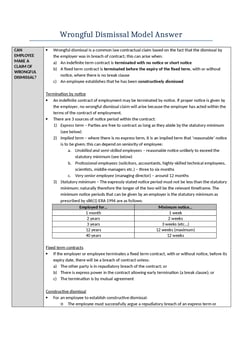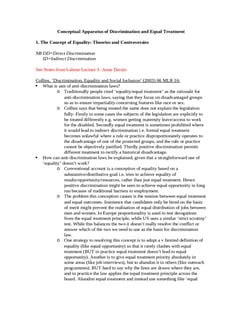Rutherford & Bentley v SoS for Trade and Industry [2006] IRLR 551
Judgement for the case Rutherford & Bentley v SoS for Trade and Industry
Table Of Contents
It was considered whether the rules in S. 109 and 156 of the Employment Rights Act 1996, which provided that those employees who were over the age of 65 (or such other normal retirement age as was provided for by an employer) were not entitled to a redundancy payment and did not qualify for the protection against unfair dismissal, amounted to indirect sex discrimination.
It was alleged by Mr. Rutherford and Mr. Bentley that the rules were indirectly discriminatory, under EC law (Article 141), on the basis that the working lives of men and women were different and, in particular, that a greater proportion of men than women tended to work beyond the age of 65, so that the legislation had a greater effect on men.
HL held that the compulsory retirement age was not discriminatory.
Lord Rodger
They simply disagreed on the basis of empirical evidence as to actual alleged discriminatory effect.
What Article 141 does not do is guarantee that a man over 65 will have the same (higher) level of pay as a woman under 65 doing equal work.
Parliament has decided that a younger woman, who has worked for her employer for more than a year, should have rights which a man or woman over 65 does not have. The man over 65 can claim no more than to receive pay equal to the pay of a woman over 65 for equal work.
In the usual jargon, the woman over 65 is the appropriate comparator…would have to show that a substantially higher proportion of the men over 65 who work than of the women over 65 who work receive merely the reduced pay package.
In fact, however, the statistics show no such thing since, subject to section 156(1)(a) of the 1996 Act, 100% of both groups receive it.
Lady Hale
The alleged comparison is between those who are still working at 65 - disadvantaged group - and those who have stopped working by then.
It makes no sense to compare the two since the latter is simply a group to whom the legislation doesn’t apply, and a group to which anyone who wants to can belong.
Indirect discrimination cannot be shown by bringing into the equation people who have no interest in the advantage or disadvantage in question.
-
There could be no indirect discrimination of the separating rule type since there was no separating rule creating a winning group and a losing group.
Rather, the correct comparison is between men and women who are working when aged 65+. As Lord Rodger says, they both get the same pay.
Lord Walker (different approach)
The pool for purposes of comparison comprised all those employed persons on whom rights were conferred by the 1996 Act.
[The] legislation applies generally to all employed persons on whom rights are conferred by the 1996 Act. As a matter of general principle, therefore, the pool should be all those persons.
Making a comparison between the proportions of men and women in that group advantaged by the cut-off age, which was the appropriate approach, there was no significant disparity.
In the make-up of the group comprising those not adversely affected by the cut-off age there was virtually nothing to choose between men and women, and, although a higher proportion of men than of women continued in employment after age 65, the ratio of about 1:1.4 in a group comprising only about 1.2% of the workforce was not sufficient to establish the degree of disparity necessary to establish that the legislation had an adverse impact on a substantially higher proportion of men than of women.
-
He says that in some extreme cases (where, of those affected, for example, all those disadvantaged were women and there were 5% of workforce who were disadvantaged, then this could be discrimination).
Where to draw the line between the general ‘advantage-led’ approach (as Walker applies here, in saying that vast majority of people not disadvantaged and equal breakdown of those not disadvantaged) and disadvantage-led approach (looking at proportions of those who are disadvantaged)?
----
This case goes to the heart of whether a comparator is needed and hence whether we are looking at equality or social inclusion as basis for discrimination laws (see Green article above).
NB this case concerned Article 141 and a directive which finds sex discrimination if a law / measure. etc/ detriments “a substantially higher proportion of the members of one sex” which is very similar to SDA definition.
RELATED CASES
For Further Study on Rutherford & Bentley v SoS for Trade and Industry

A collection of the best LPC Employment notes the director of Oxbridge ...
Need instant answers? Our AI exam tutor is here to help.
Ask questions 🙋 Get answers 📔 It's simple 👁️👄👁️
Our AI is educated by the highest scoring students across all subjects and schools. Join hundreds of your peers today.
Get StartedSimilar Cases
Related Product Samples
These product samples contain the same concepts we cover in this case.
| Employment Law | Indirect Discrimination Harassment And Et1 3 Forms Notes (38 pages) |
| Labour Law | Labour Discrimination Notes (64 pages) |

 Since 2010, Oxbridge Notes has been a trusted education marketplace, supplying high-quality materials from top achievers at universities like Oxford, Cambridge, LSE, Harvard, and Yale.
Since 2010, Oxbridge Notes has been a trusted education marketplace, supplying high-quality materials from top achievers at universities like Oxford, Cambridge, LSE, Harvard, and Yale.